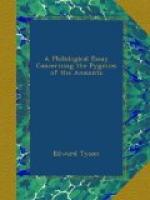[Footnote A: Quoted by Keightley (p. 9), from Thiele, i. 118.]
[Footnote B: Keightley, 178.]
2. The haunts of the fairies may be in caves, and examples of this form of dwelling-place are to be met with in different parts of the world. The Scandinavian hill people live in caves or small hills, and the Elves or dwarfs of La Romagna “dwell in lonely places, far away in the mountains, deep in them, in caves or among old ruins and rocks,” as Mr. Leland,[A] who gives a tale respecting these little people, tells us. A Lithuanian tale[B] tells “how the hero, Martin, went into a forest to hunt, accompanied by a smith and a tailor. Finding an empty hut, they took possession of it; the tailor remained in it to cook the dinner, and the others went forth to the chase. When the dinner was almost ready, there came to the hut a very little old man with a very long beard, who piteously begged for food. After receiving it, he sprang on the tailor’s neck and beat him almost to death. When the hunters returned, they found their comrade groaning on his couch, complaining of illness, but saying nothing about the bearded dwarf. Next day the smith suffered in a similar way; but when it came to Martin’s turn, he proved too many and too strong for the dwarf, whom he overcame, and whom he fastened by the beard to the stump of a tree. But the dwarf tore himself loose before the hunters came back from the forest and escaped into a cavern. Tracing him by the drops of blood which had fallen from him, the three companions came to the mouth of the cavern, and Martin was lowered into it by the two others. Within it he found three princesses, who had been stolen by three dragons. These dragons he slew, and the princesses and their property he took to the spot above which his comrades kept watch, who hoisted them out of the cavern, but left Martin in it to die. As he wandered about disconsolately, he found the bearded dwarf, whom he slew. And soon afterwards he was conveyed out of the cavern by a flying serpent, and was able to punish his treacherous friends, and to recover the princesses, all three of whom he simultaneously married.”
[Footnote A: Etrusco Roman Remains, p. 222.]
[Footnote B: Folk Lore Record, i. 85. Mr. Hartland points out to me that this tale, being a Marchen, does not afford quite such good evidence of belief as actually or recently existing as a saga.]
Amongst the Magyars,[A] also, in some localities caves are pointed out as the haunts of fairies, such as the caves in the side of the rock named Budvar, the cave Borza-vara, near the castle of Dame Rapson; another haunt of the fairies is the cave near Almas, and the cold wind known as the “Nemere” is said to blow when the fairy in Almas cave feels cold. On one occasion the plague was raging in this neighbourhood; the people ascribed it to the cold blast emanating from the cave; so they hung shirts before the mouth of the cave and the plague ceased.




